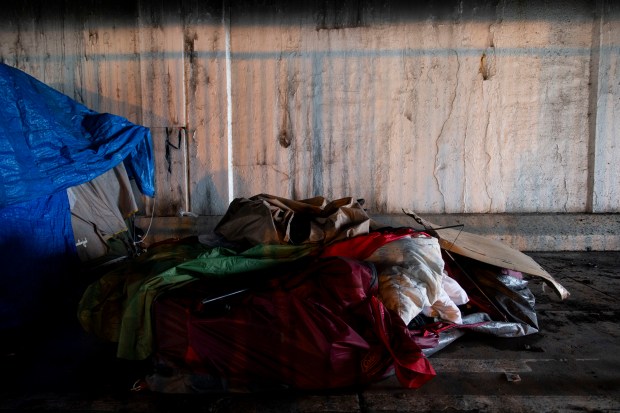Hours after the fire truck left and debris was swept away, Uptown’s Lawrence Avenue viaduct still smelled like smoke.
Soot blackened the walls and the ceiling of the underpass. It crept onto the siding a few feet below the cars hurtling up and down DuSable Lake Shore Drive.
“It’s usually fried, but not this fried,” said a man who calls himself Steezy and lives about 100 feet from the viaduct.
Early Thursday morning, a woman had reportedly set her tent on fire, and before the Chicago Fire Department could respond, at around 4:40 a.m., two other storage tents burned up in the homeless encampment under the viaduct.
No injuries were reported, said Fire Department spokesperson Larry Langford. A Chicago Department of Transportation representative said the underpass was inspected Thursday for damage. A city spokesperson said workers from the Department of Family Support Services visited the encampment for outreach to residents in the wake of the fire.
Steezy, 39, said he had seen the whole thing. As he stood with a skateboard tucked under his arm at the damp eastern mouth of the viaduct Thursday evening, he gestured westward at the path he’d watched the flames follow.
Once it was going, he said, something burning would hit the tunnel’s ceiling, and then a rain of sparks would fall on the next tent.
Although no one was injured in the early morning blaze, the fire is the latest example of the hazards Chicago’s roughly 68,000 homeless people face daily, said Patricia Nix-Hodes of the Chicago Coalition for the Homeless. Besides fires set by homeless people themselves, whether by accident or on purpose, attacks from the wider population also pose a risk to people without a place to go.
Perhaps most famous among recent attacks is the death of Joseph Kromelis, better known as Chicago’s “Walking Man,” who died in 2022, months after a man set him on fire while he was asleep on the street.
Residents of the Lawrence viaduct and another encampment a few blocks south said fire is relatively common in the area. It’s sometimes used to settle disputes between neighbors or as a coping mechanism. Indeed, one neighbor thought the woman had set fire to her tent because she’d overheard others planning to burn her things and decided to do it first.
Another neighbor thought she did it because she couldn’t handle the rats running around her tent.
“There’s a variety of safety risks that face people when they’re living outdoors, but there’s also sometimes no other adequate alternatives for people,” Nix-Hodes said. The only long-term solution to these dangers, Nix-Hodes said, is improving the supply of affordable and supportive housing.
But Chicago is divided on how to address the city’s struggle with homelessness.
Voters last month rejected the Bring Chicago Home referendum, which sought to raise the city’s real estate transfer tax on property purchases above $1 million to generate up to $100 million annually for homeless services. Though Mayor Brandon Johnson and others supporting the referendum have pledged to press on with the measure, Nix-Hodes said the referendum was “certainly not the only approach” to fund solutions.
Weeks after the referendum failed, Johnson appointed Sendy Soto to serve as Chicago’s first chief homelessness officer, tasked with developing a five-year plan to reduce homelessness.
In Uptown, a woman who identified herself only as “L” said she’d witnessed the blaze from the southern side of the tunnel. From her tent, she said, she’d been able to see light from the flames across the road.
She said it was beautiful. She figured the batteries, glass and propane among the stored items made the blaze so intense.
L has lived in the viaduct for about a year and estimates she has seen about 10 fires in that time. She set a few herself.
Most of L’s things had been in one of the burned storage tents. She’d lost a jacket she loved and some keepsakes she’d been holding onto for one of her sisters. The shopping cart she used to take her clothes to the laundromat had its wheels melted off in the fire.
She was irritated about losing her stuff, she said. On the other hand, she said, these were just things.
Despite the fires and the disagreements among neighbors, she said the community of people who live in and around the viaduct look out for each other and check in on each other nightly.
“When I don’t see people for a few days, I get concerned,” she said.
She gestured at Steezy, who was pointing out burn marks that resembled human faces on the northern wall of the viaduct.
“Family doesn’t always have to have your last name. Like this dummy right here,” she said with affection.
While she has been trying to get housing, she has been unsuccessful so far. But she said if she is going to live outside, she likes it under the viaduct.
“I feel at peace here,” she said, “even though there really is no peace.”



